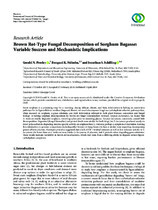| dc.contributor.author | Presley, Gerald N. | |
| dc.contributor.author | Ndimba, Bongani K. | |
| dc.contributor.author | Schilling, Jonathan S. | |
| dc.date.accessioned | 2018-04-18T13:26:05Z | |
| dc.date.available | 2018-04-18T13:26:05Z | |
| dc.date.issued | 2018 | |
| dc.identifier.citation | Presley, Gerald N. et al. (2018). Brown rot-type fungal decomposition of sorghum bagasse: variable success and mechanistic implications. International Journal of Microbiology, 2018: 4961726 | en_US |
| dc.identifier.issn | 1687-9198 | |
| dc.identifier.uri | http://dx.doi.org/10.1155/2018/4961726 | |
| dc.identifier.uri | http://hdl.handle.net/10566/3600 | |
| dc.description.abstract | Sweet sorghum is a promising crop for a warming, drying African climate, and basic information is lacking on conversion
pathways for its lignocellulosic residues (bagasse). Brown rot wood-decomposer fungi use carbohydrate-selective pathways that,
when assessed on sorghum, a grass substrate, can yield information relevant to both plant biomass conversion and fungal
biology. In testing sorghum decomposition by brown rot fungi (Gloeophyllum trabeum, Serpula lacrymans), we found that
G. trabeum readily degraded sorghum, removing xylan prior to removing glucan. Serpula lacrymans, conversely, caused little
decomposition. Ergosterol (fungal biomarker) and protein levels were similar for both fungi, but S. lacrymans produced nearly 4x
lower polysaccharide-degrading enzyme specific activity on sorghum than G. trabeum, perhaps a symptom of starvation. Linking
this information to genome comparisons including other brown rot fungi known to have a similar issue regarding decomposing
grasses (Postia placenta, Fomitopsis pinicola) suggested that a lack of CE 1 feruloyl esterases as well as low xylanase activity in S.
lacrymans (3x lower than in G. trabeum) may hinder S. lacrymans, P. placenta, and F. pinicola when degrading grass substrates.
These results indicate variability in brown rot mechanisms, which may stem from a differing ability to degrade certain lignincarbohydrate
complexes. | en_US |
| dc.language.iso | en | en_US |
| dc.publisher | Hindawi Publishing Corporation | en_US |
| dc.rights | Copyright © 2018 Gerald N. Presley et al. This is an open access article distributed under the Creative Commons Attribution
License, which permits unrestricted use, distribution, and reproduction in any medium, provided the original work is properly
cited. | |
| dc.subject | Renewable biofuel | en_US |
| dc.subject | lignocellulosic residues | en_US |
| dc.subject | Brown rot fungi | en_US |
| dc.subject | Sorghum | en_US |
| dc.title | Brown rot-type fungal decomposition of sorghum bagasse: variable success and mechanistic implications | en_US |
| dc.type | Article | en_US |
| dc.privacy.showsubmitter | FALSE | |
| dc.status.ispeerreviewed | TRUE | |

